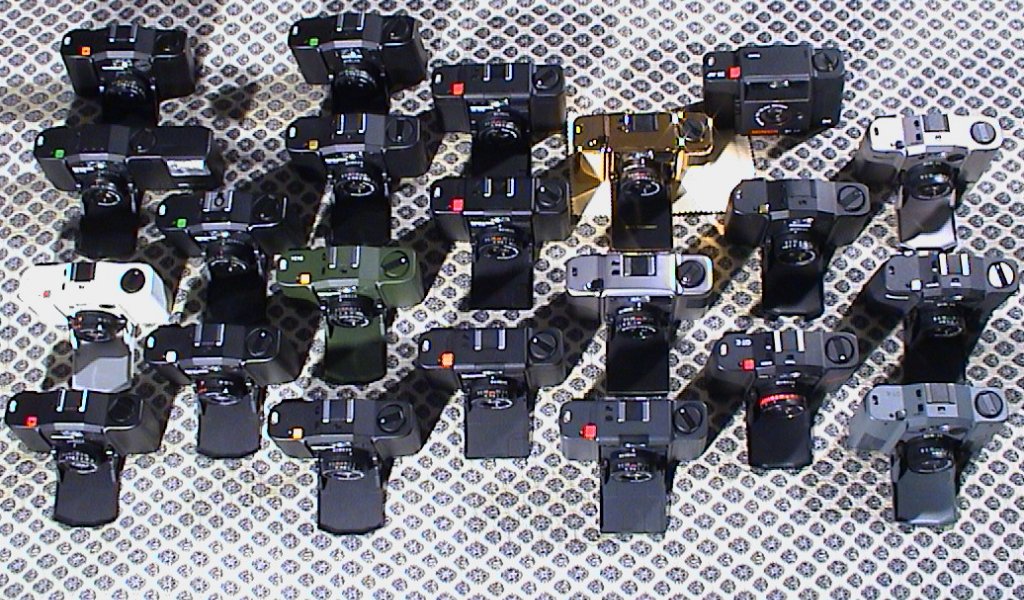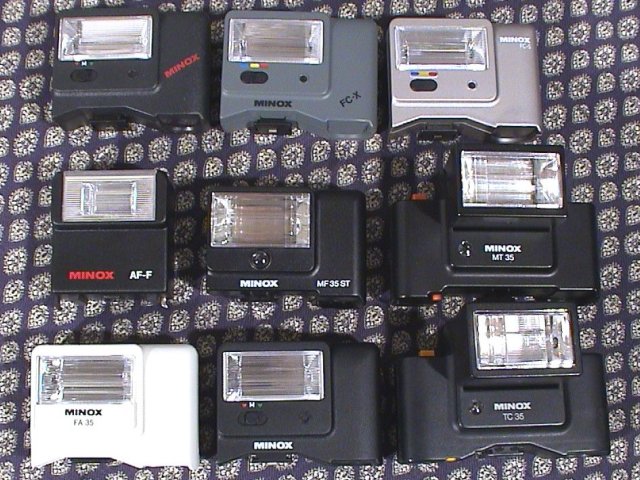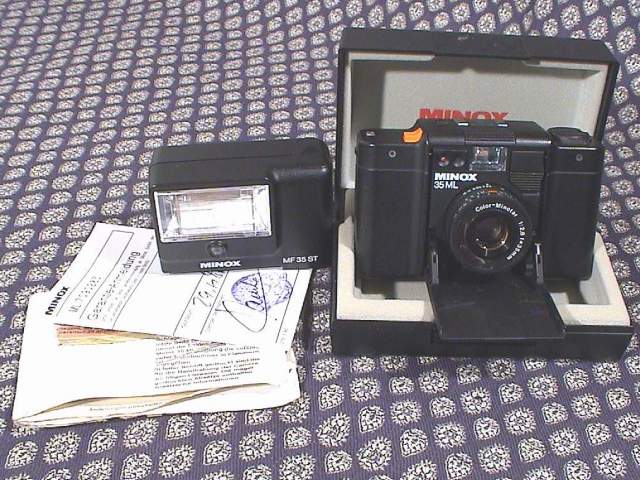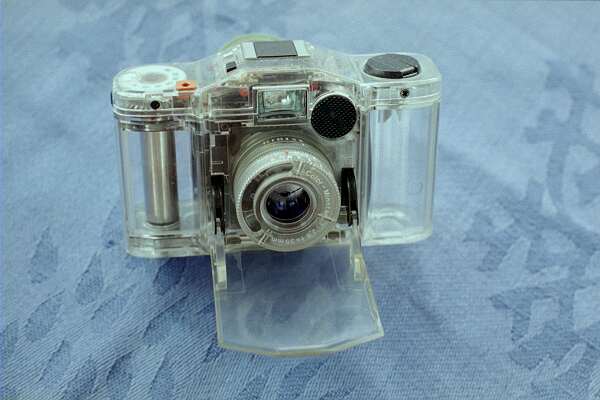The Minox 35mm range was introduced in 1974, along with the 110S and continued the direct line of models until the last of the 35mm compact cameras with the GT-E II and GT-S. Similar in size to the Rollei 35B and 35S cameras both having a lens that pops forward in use. The Minox's draw-bridge provides both protection to the lens and makes a smooth line when closed, making it one of the easiest cameras to slip in and out of your pocket. However, a case is recommended to avoid dust and scratches and you will need a different case if you have a data back as the standard case is too small.
Although much larger than the 8x11 range of cameras and at 190g (compared to a Minox C at 114g) they are light and compact compared to many 16mm and 110 cameras.
The Minox GTE has a volume of only 11.23 cubic inches ( 3.9 x 2.5 x 1.2 inches) -- 20% smaller then the smallest half frame Fuji Mini at 3.5"x2.5"x1.5" - what an engineering feat from Minox!

The Minox 35 series have been designed by Professor Richard Fischer. They are made of glass-fibre reinforced Makrolon. Glass fibre will reflect light and so the lacquer finish must be matt black and light tight. This is a particular problem on the Kiev 35.
The Minox camera are divided into three family groups (see History Chart). Accessories may not be suitable across all family groups, in particular the flash units.

If you include the size of a Minox flash the 35mm cameras are huge compared to many other excellent compact 35mm cameras, from other manufactures, that offer a tiny built in flash .

Between 1974 and 2003 Minox manufactured thirty models in the 35mm range. Besides the standard camera model there is the special releases of the 35GT for Karstadt - the Sport , the MB marked "Service-Camera" and for the automobile industries several marked with the car manufacture's logo, such as Mercedes. A number of sets where offered with flash and cases or databack.
The AF, CD (e.g. CD150 at only 113 mm x 60 mm x 45 mm) and digital (e.g. DC2122 105 x 55 x 45 mm) ranges are outside even the widest definition of subminiature, and are included here only for completeness and Minox's special place in the world of subminiature cameras.
There are special display versions of the 35EL made out of glass, and also some display models made of transparent plastic, like the GL model below (which sold for 500GBP on 2004/09/05).

The release button of the types EL and GL is threaded for a cable release. As this could lead to premature triggering a special accessory was made for it. Later models have a separate cable release thread to avoid this problem.
From the GL there is a 10 second self timer and a back light switch.
Minox list the 35PL/35PE (1982/83) and 35AL separately in their history Chart with the PL/PE being automatic with the aperture settings only being used for flash and the AL being fixed focus with aperture set by weather symbols.
In 1985 Minox launched the Minox 35ML. The body shape is slightly different and the meter is read from red LEDs. This series accumulated in the MDC with aluminium body coated with titan anodising and the limited gold-plated edition. These cameras use the PX28, slightly longer than the PX27 and easier to obtain. The MDC has click stops for the setting of the aperture, unlike all the other models which are continuous.
Until the launch of the special edition GT "Golf" in 1984 all the cameras where a uniform black and then in 1987 the AL was made available also in white. This is not white plastic, but a white coating over the black Makrolon. Samples that have been heavily used show signs of wear and chips in the finish.
The MB Touring model has a greyish charcoal colour. The MDC has a silvery titan anodised aluminium shell over the black Makrolon case. A limited edition of 555 MDC are gold plated.
The GT-E and gold button (goldknoff) have a curved slightly convex lens cover and the GT-E has ribbed corners where finger and thumb hold the camera. The cameras now came supplied with two CR1/3N batteries and a replacement adapter was made available for earlier models, although only with a black cover (not in green for the 35GT Golf and 35GT Sport model).
The GT-X was produced in a limited edition of 1000 with 50 years of MINOX engraved lightly in the view finder. The GT-X is a steel blue grey colour. The GT-X has DX coding, like the silver grey GT-S.
The GT-E II has a soft touch finish giving the camera a very tactile feel and a dark grey appearance.
The shutter release button varies with the model. The goldknoff has an 18 caret gold button and gold trim around the lens, seen behind the glass.
The lens is a Tessar with 4 lenses in 3 groups with front lens focusing.
The Minoxar has a skylight filter and the shift in the lens gives a close focusing of 0.7metres. The earlier Minotar lens has a close distance focusing of 0.9metres. The aperture has an odd shape being a kite shape. At f5.6 the image is sharp to the edge. This makes for stunning results that is is hard to be believed can be bettered. Many owners of Minox 35mm cameras also own Rollei 35 and these two ranges are frequently compared in size, features and image quality. The general consensus is that the Rollei's lens is slightly better, but the camera is both heavier and harder to slip in and out of your pocket to use quickly.
The 'FI' was engraved on all Minox 35 cameras imported by FOWA, Italy, the exact position depending upon the model. On the EL, GL, GT, PL, PE it is engraved directly on the camera body near the objective (left side), on the ML, MB it is on the right side, under the battery tray. Last imported models GTE, GSE have the 'FI' marked on the inside of the front flap. The markings was to prevent irregular importation. FOWA was the main dealer for east Europe, specially for espionage equipment and that differentiates it from other EEC (the original 6 members of the EU) and European countries that imported Minox cameras.
Metric (DIN) and imperial (feet/ASA) versions have been made for each model. The English handbook only has measurements denoted in feet, even though the majority of the English speaking countries converted to metric before the first 35EL camera. Handbooks are available in a number of languages including German, French, Spanish and Italian as well as the English. Minox also supply replacement handbooks, even if, for some models this is only a photocopy.
The early models, in particular any 'L' model {EL, GL, AL, ML} have a history and reputation for poor shutter reliability. The warranty repairs on the early G and M series cameras contributed to the decline of Minox GmbH in the 80s. Cameras left idle for a decade or more will need the contacts cleaning but then should present no additional problem. Most Minox 35mm cameras can be repaired. Minox deserve strong praised for the support for cameras that are long out of production and may never have been expected to still be in use a quarter of a century later. Unfortunately some parts have been unavailable for a long time and so an expensive second hand camera might turn out to be just scrap.
Other Minox 35mm and compact cameras
Minox also produced three other lines of compact cameras. The AF in the AF Mini and AF and then, with involvement from Leica the AF-90 which lead to the CD series of compact cameras including their only APS camera (CD25) and then the DC series of digital cameras in 2001 starting the DC-1311, an OEM version of the Pentax Ei-100.
The AF has been dubbed the ugliest Minox camera ever. It has the appearance of the classic 35mm cameras but without a cover for the lens and two fish eye sensors behind a transparent plastic dome.
The AF mini is a solid and simple camera but the AF-90 is very un-Minox with a cheap plastic feel and no discernable merits. Compared to the Leica compact zoom cameras (e.g. Z2X) the CD range feel bulkier, more plastic and cheap. Even with the soft touch finish on the later models M*142 and CD 140, 155 and 150 it is only the Minox name and optics that retains the interest in these models.
See also:-
Merchandising
(see also under 8x11)